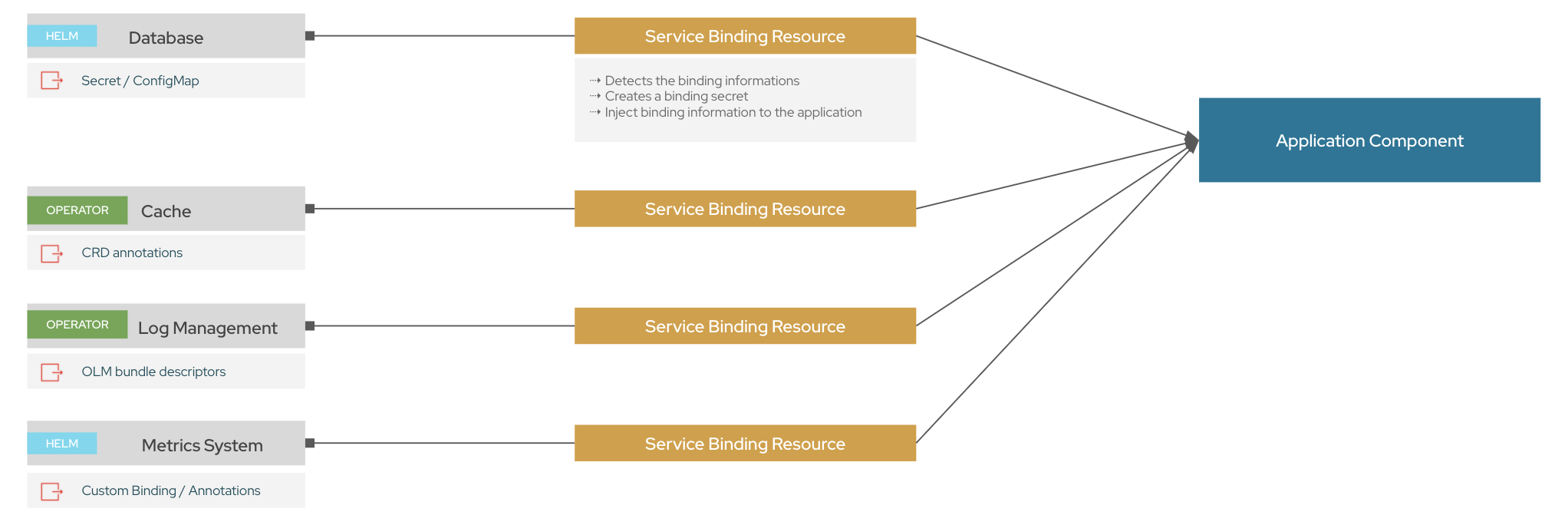Introduction
The Service Binding Operator consists of a controller and an accompanying custom resource definition (CRD) for service binding. It manages the data plane for workloads and backing services. The Service Binding Controller reads the data made available by the control plane of backing services. Then, it projects this data to workloads according to the rules specified through the ServiceBinding resource.

Why service bindings?
Application developers need access to backing services to build and connect workloads. Today in Kubernetes, the exposure of secrets for connecting workloads to external services such as REST APIs, databases, event buses, and many more is manual and custom-made. Connecting workloads to backing services is always a challenge because each service provider suggests a different way to access their secrets, and each application developer consumes those secrets in a custom way to their workloads. While there is a good deal of value to this flexibility level, large development teams lose overall velocity dealing with each unique solution. In addition, manual configuration and maintenance of this binding together of workloads and backing services make the process tedious, inefficient, and error-prone.
With Service Binding Operator, you can:
-
Bind your workloads to backing services or external services.
-
Automate configuration of binding data.
-
Provide service operators a low-touch administrative experience to provision and manage access to services.
-
Enrich development lifecycle with a consistent and declarative service binding method that eliminates discrepancies in cluster environments.
Features
Exposal of binding data from services
-
Based on annotations present in CRD, custom resources (CRs), or resources.
-
Based on descriptors present in Operator Lifecycle Manager (OLM) descriptors.
Workload projection
-
Projection of binding data as files, with a volume mounts.
-
Projection of binding data as environment variables.
Service Binding Options
-
Bind backing services in a namespace that is different from the workload namespace.
-
Project binding data into the specific container workloads.
-
Auto-detection of the binding data from resources owned by the backing service CR.
-
Change the binding names before projecting them into workload.
-
Compose custom binding data from the exposed binding data.
-
Support for non-
PodSpeccompliant workload resources.
Understanding Service Binding Operator
The Service Binding Operator enables application developers to easily bind workloads together with backing services or external services, by automatically collecting and sharing binding data with the workloads. The process involves making the backing service bindable and binding the workload and the service together.
Making an Operator-managed backing service bindable
To make a service bindable, as an Operator provider you need to expose the binding data required by workloads to bind with the services provided by the Operator. You can provide the binding data either as annotations or as descriptors in the CRD of the Operator that manages the backing service.
Binding a workload together with a backing service
By using the Service Binding Operator, as an application developer, you need to declare the intent of establishing a binding connection. You must create a Service Binding CR that references the backing service. This action triggers the Service Binding Operator to project the exposed binding data into the workload. The Service Binding Operator receives the declared intent and binds the workload together with the backing service.
The CRD of the Service Binding Operator supports the following APIs:
-
Service Binding with the
binding.operators.coreos.comAPI group.This API is compliant with the Service Binding specification. It is fully supported and considered as the mature API. Use this API in production environments.
-
Service Binding (Spec API Tech Preview) with the
servicebinding.ioAPI group.This API is defined in the Service Binding specification. The specification is still evolving and maturing. As a result, the API might change in the future. Use the API carefully for testing purposes and preparing your integration to become fully compliant with the specification. The API is available in Service Binding Operator 1.x, as Tech Preview.
We will consider supporting only the servicebinding.io API group from the specification, after the Service Binding specification will be officially GA. Any resulting breaking changes will be handled safely.
|
Some of the key difference between the APIs:
| binding.operators.coreos.com API | servicebinding.io API |
|---|---|
Support naming strategy |
Does not support naming strategy |
Support custom mapping |
Does not support custom mapping |
Support to auto-detect binding resources |
Does not support auto-detecting binding resources |
Flag to bind as files or env vars |
No flag switch between files and env vars |
Referenced specification
Service Binding Operator supports the Service Binding Specification for Kubernetes.